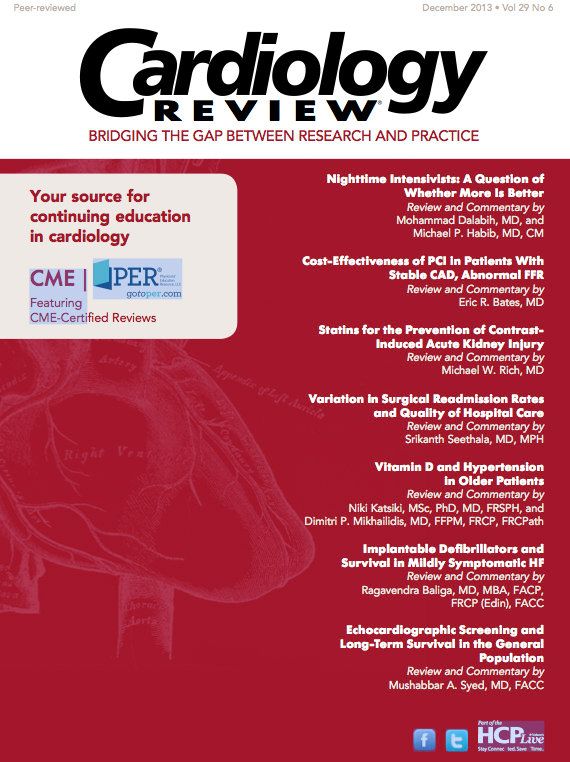Publication
Article
Cardiology Review® Online
What Is the Optimal Duration of Dual Antiplatelet Therapy After DES?
For this edition of Clinical Forum, we asked 3 Cardiology Review editorial board members to comment on the optimal duration of dual antiplatelet therapy after placement of drug-eluting stents. Here are their responses.
Please send your comments or suggestions for future Cardiology Review Clinical Forum questions to Dr. Mukherjee at debabrata.mukherjee@ttuhsc .edu. Space permitting, we will post them online and in the iPad edition of the next issue.
Q: What is the optimal duration of dual antiplatelet therapy after DES?

Hitinder S. Gurm, MD,
Ass ociate Professor of Internal Medicine
Director, Inpatient Cardiology Services
Division of Cardiovascular Medicine
University of Michigan
Ann Arbor, MI
A: The duration of dual anti-platelet therapy (DAPT) after placement of drug-eluting stents (DESs) has become a much more nuanced decision in light of recent data. Originally, when the first-generation DES came into use, DAPT was recommended for 3 months for a sirolimus-eluting stent (SES) and for 6 months for a paclitaxel-eluting stent (PES). Premature discontinuation of DAPT was soon recognized as a major predictor of stent thrombosis, especially in patients who had originally presented with an acute coronary syndrome (ACS).1,2 In parallel, late and very late stent thrombosis were recognized as a rare but major complication of DESs, and the duration of DAPT was prolonged to 1 year in an effort to prevent these late complications. This approach was endorsed by society guidelines from both sides of the Atlantic3,4 although there were sparse randomized data to support such a strategy.
The optimal duration of DAPT in contemporary practice continues to be debated due to the replacement of the first-generation DESs by the secondgeneration DESs. These stents have replaced the first-generation stents in clinical practice because of better deliverability, similar or better anti-restenotic efficacy, enhanced endothelialization, and lower rates of stent thrombosis. Based on indirect comparisons, Palmerini and colleagues have hypothesized that the second-generation DES (or at least everolimus-eluting stents [EES]) may lower stent thrombosis compared with bare metal stents.5
Almost all of the studies evaluating the secondgeneration DESs used 9 to 12 months of DAPT, and 1 year of DAPT remains the standard clinical practice at this point. Emerging data suggest that it may be time to reconsider this approach. Prolonged DAPT is associated with an increased risk of bleeding, the need to delay invasive procedures, and increased cost. A strategy of 3 months versus 1 year of DAPT has been compared in multiple studies. The OPTIMISE trial randomized 3119 patients undergoing PCI for stable coronary artery disease or low-risk acute coronary syndrome with a zotarolimus-eluting stent (ZES) to 3 versus 12 months of DAPT. The primary end point of net adverse clinical and cerebral events (NACCE; a composite of all-cause death, myocardial infarction [MI], stroke, or major bleeding) was similar in the 2 arms (6.0% vs 5.8%, respectively; risk difference, 0.17 [95% confidence interval (CI), −1.52 to 1.86]; P = .002 for noninferiority). There was no difference in NACCE between 91 and 360 days (2.6% vs 2.6%) or stent thrombosis (0.3% vs 0.1%; hazard ratio [HR], 3.97 [95% CI, 0.44-35.49]). Surprisingly, no difference in major bleeding was observed with shorter duration of DAPT.6 These results corroborate the findings from the RESET (Real Safety and Efficacy of 3-Month Dual Antiplatelet Therapy Following Endeavor Zotarolimus-Eluting Stent Implantation) trial, in which 2117 patients were randomized to treatment with zotarolimus-eluting stents plus 3 months of DAPT versus first- or second-generation drug-eluting stents plus 12 months of DAPT. At 1 year, there was no difference in the primary outcome (cardiac death, MI, stent thrombosis, or ischemiadriven target-vessel revascularization) between the 2 groups.7
It may be premature to switch to short-term DAPT for all patients based on these trials. These trials were not adequately powered to look at stent thrombosis, and the stent platform that was tested in these trials— the Endeavor ZES—has been replaced by the Resolute ZES. It is not clear if the safety of 3 months of DAPT can be directly applied to the Resolute ZES (with better anti-restenotic efficacy and different drug-release kinetics) or the EES. However, the low event rates in both arms are reassuring and suggest that either approach may be reasonable under different circumstances.
That brings us back to the original question. How long should a patient be on DAPT after a DES? The optimal duration of DAPT in a patient with a DES should be guided by a careful assessment of risk of bleeding versus thrombosis rather than the standard approach of 1 year of DAPT for all. Patients with high-risk ACS should be treated with 1 year of DAPT. Longer duration of DAPT should be considered for patients at higher risk of stent thrombosis, such as those undergoing bifurcation stenting, left main stenting, DES for prior restenosis (in a bare metal or a DES), those who have had prior brachytherapy, or stenting in ectatic segments. DAPT for 3 months should be considered in those at high risk of bleeding. For all others, I would still favor DAPT for 1 year, but with a fairly low threshold for stopping after 90 days if there was any clinical indication to do so.
References
1. Airoldi F, Colombo A, Morici N, et al. Incidence and predictors of drug-eluting stent thrombosis during and after discontinuation of thienopyridine treatment. Circulation. 2007;116:745-754.
2. Spertus JA, Kettelkamp R, Vance C, et al. Prevalence, predictors, and outcomes of premature discontinuation of thienopyridine therapy after drug-eluting stent placement: results from the PREMIER registry. Circulation. 2006;113:2803-2809.
3. Levine GN, Bates ER, Blankenship JC, et al. 2011 ACCF/AHA/SCAI Guideline for Percutaneous Coronary Intervention: a report of the American College of Cardiology Foundation/American Heart Association Task Force on Practice Guidelines and the Society for Cardiovascular Angiography and Interventions. J Am Coll Cardiol. 2011; 58:e44-e122.
4. Wijns W, Kolh P, Danchin N, et al. Guidelines on myocardial revascularization. Eur Heart J. 2010;31:2501- 5255.
5. Palmerini T, Biondi-Zoccai G, Della Riva D, et al. Stent thrombosis with drug-eluting and bare-metal stents: evidence from a comprehensive network meta-analysis. Lancet. 2012;379:1393-1402.
6. Feres F, Costa RA, Abizaid A, et al. Three vs twelve months of dual antiplatelet therapy after zotarolimuseluting stents: the OPTIMIZE randomized trial [published online October 31, 2013]. JAMA. doi:10.1001/ jama.2013.282183.
7. Kim BK, Hong MK, Shin DH, et al. A new strategy for discontinuation of dual antiplatelet therapy: the RESET Trial (REal Safety and Efficacy of 3-month dual antiplatelet Therapy following Endeavor zotarolimus-eluting stent implantation). J Am Coll Cardiol. 2012;60:1340-1348. Q: What is the optimal duration of dual antiplatelet therapy after DES?

Timir Paul, MD, PhD, MPH, FACC
Assistant Professor of Medicine
Division of Cardiology
Director, Cardiac Rehabilitation and Prevention
Quillen College of Medicine
East Tennessee State University
A: Dual antiplatelet therapy (DAPT) with aspirin and a thienopyridine/P2Y12 receptor antagonist is the standard of care in patients with acute coronary syndrome (ACS) and following percutaneous coronary intervention (PCI). However, the optimal duration of DAPT remains undefined after drug-eluting stent (DES) implantation.
The 2011 American College of Cardiology Foundation/ American Heart Association/Society for Cardiovascular and Angiographic Interventions guidelines for PCI recommend at least 12 months of DAPT after DES implantation and in ACS patients irrespective of revascularization strategy (class I).1 If risk of bleeding outweighs the benefits, earlier discontinuation of DAPT is reasonable (class IIa).1 The European Society of Cardiology recommends 6 to 12 months of DAPT after DES and 12 months for all ACS patients regardless of the stent utilized.
The PRODIGY trial showed that 24 months of DAPT was not more effective than 6 months in decreasing the risk of all-cause mortality, myocardial infarction (MI), or cerebrovascular accident (CVA), but was associated with increased risk of bleeding.2 The results of a combined analysis of the REAL-LATE and ZEST-LATE trials did not reveal improved cardiovascular outcomes in patients who received >12 months of DAPT after a mean followup of 19.2 months.3 A pooled analysis of 5 prospective trials demonstrated that the late events of death, MI, and stent thrombosis did not differ significantly among patients treated with zotarolimus-eluting stents taking DAPT for 6 months versus ≥12 months or 6 months versus ≥24 months. There was no difference in stent thrombosis even up to 3 years of follow- up.4 The EXCELLENT trial revealed that at 12 months, there is no significant difference in rates of a composite of cardiac death, MI, or target vessel revascularization between the 6-month and 12-month DAPT groups following DES implantation.5 Results of a meta-analysis suggest that DAPT discontinuation before 6 months significantly increased the risk of death and nonfatal MI, but continuation of DAPT beyond 12 months did not reduce the incidence of the composite end point compared with drug discontinuation at 12 months.6 Another meta-analysis indicated that at a median follow-up of 16.8 months, prolonging DAPT did not reduce all-cause mortality, MI, ST, or CVA, but rather increased the risk of TIMI major bleeding.7 To the contrary, National Heart, Lung, & Blood Institute dynamic registry data showed a reduced 4-year rate of death or MI in patients on DAPT for 24 months compared with those who are not.8
The above studies provide some evidence that DAPT therapy for 6 months may be safe, especially with newer-generation DES, but the optimal duration of DAPT following DES is yet to be determined. There is not enough evidence indicating indefinite or long-term benefits of DAPT after DES, especially beyond 12 months. Data showed that higher risk of stent thrombosis is associated with DAPT discontinuation before 6 months, but there is no concrete evidence supporting a highly beneficial effect of DAPT after 6 months in reducing cardiovascular events.
We should continue DAPT for at least 6 months and preferably 12 months after DES unless contraindicated. The decision about shorter (6 months) and longer duration (6-12 months) should be individualized by careful assessment of a balance between stent thrombosis and risk of bleeding. Longer duration of DAPT should be considered for patients with a higher risk of stent thrombosis. Shorter duration of DAPT would be reasonable for patients with increased risk of bleeding and patients with atrial fibrillation and/ or mechanical valves requiring triple antithrombotic therapy. Risk scores such as HAS-BLED9 may be used to make clinical decisions when longer-term anticoagulation and DAPT is required, and DERIVATION10 scores when shorter-term DAPT is required for non-compliant patients, increased bleeding risk, and urgent surgery.
References
1. Levine GN, Bates ER, Blankenship JC, et al. 2011 ACCF/ AHA/SCAI guideline for percutaneous coronary intervention: executive summary. Circulation. 2011;124:2574- 2609.
2. Valgimigli M, Campo G, Monti M, et al, and the PRODIGY Investigators. Short- versus long term duration of dual antiplatelet therapy after coronary stenting. Circulation. 2012;125:2015-2026.
3. Park SJ, Park DW, Kim YH, et al. Duration of dual antiplatelet therapy after implantation of drug-eluting stents. N Engl J Med. 2010;362:1374-1382.
4. Kandzari DE, Barker CS, Leon MB, et al. Dual antiplatelet therapy and clinical outcomes following treatment with Zotarolimus-eluting stents. J Am Coll Cardiol Interv. 2011;4:1119-1128.
5. Gwon H, Hahn J, Park KW, et al. Six-month versus 12-month dual antiplatelet therapy after implantation of drug-eluting stents: the efficacy of Xience/Promus versus Cypher to reduce late loss after stenting (EXCELLENT) randomized, multicenter study. Circulation. 2012;125:505- 513.
6. Zhang T, Shen L, Hu L, et al. Optimal duration of dualantiplatelet therapy following drug-eluting stent implantation: a meta-analysis. J Clin Pharmacol. 2013;53:345-351.
7. Cassese S, Byrne RA, Tada T, et al. Clinical impact of extended dual antiplatelet therapy after percutaneous coronary interventions in the drug-eluting stent era: a metaanalysis of randomized trials. Eur Heart J. 2012;33:3078- 3087.
8. Mulukutla SR, Marroquin OC, Vlachos HA, et al. Benefit of long-term dual anti-platelet therapy in patients treated with drug eluting stents: from NHLBI Dynamic Registry. Am J Cardiol. 2012;111:486-492.
9. Pisters R, Lane DA, Nieuwlaat R, et al. A novel userfriendly score (HAS-BLED) to assess 1-year risk of major bleeding in patients with atrial fibrillation: the Euro Heart Survey. Chest. 2010;138:1093-1100.
10. Capodanno D, Capranzano P, Bucalo R, et al. A novel approach to define risk of stent thrombosis after percutaneous coronary intervention with drug-eluting stents: the DERIVATION score. Clin Res Cardiol. 2009;98:240-248. Q: What is the optimal duration of dual antiplatelet therapy after DES?

Mehdi H. Shishehbor, DO , MPH, PhD
Robert & Suzanne Tomsich Department of Cardiovascular Medicine
Heart and Vascular Institute
Cleveland Clinic
Cleveland, OH
A: The current American College of Cardiology/ American Heart Association/Society of Cardiac Angiography and Intervention (ACC/ AHA/SCAI) guidelines recommend dual antiplatelet therapy (DAPT) for 12 months after percutaneous coronary intervention (PCI) with drug-eluting stents (DESs) or bare metal stents (BMS) for patients presenting with acute coronary syndromes (ACS).1 In these individuals, clopidogrel, ticagrelor, or prasugrel in addition to aspirin has a Class I indication.1 For non-ACS patients—the majority of patients undergoing PCI in the United States—only clopidogrel is approved with 12 months of therapy for DESs and at least 1 month for BMS.1
The main reason to use DAPT after PCI in non- ACS patients is to prevent stent thrombosis, often presenting as sudden death or myocardial infarction [MI]. The risk of stent thromobosis, previously reported to be as high as 2% to 3% in the first year, has significantly declined with newer DESs (everolimus and zotarolimus). Indeed, the risk of stent thrombosis in over 50,000 patients with everolimus DES was reported to be lower than the risk with BMS (odds ratio [OR] 0.23; 95% confidence interval [CI], 0.13- 0.41) at 1 year.2 Furthermore, everolimus DES was found to have lower rates of stent thrombosis than any other available DES.2 The decline in rates of stent thrombosis is in part related to better DES designs, but may also reflect better patient selection and procedural techniques. For example, since early reports of stent thrombosis, more attention has been given to stent apposition and size selection using intravascular ultrasound or quantitative angiography.
While most individuals can tolerate DAPT, many are not considered for DESs at the time of PCI because of financial inability to purchase platelet P2Y12 receptor blockers for a 1-year period. Additionally, individuals requiring surgery or even routine colonoscopy may not be offered DES because of fear of DAPT interruption. Patient compliance has also been considered a predictor of BMS use; therefore, shorter duration of DAPT may also lower the threshold to consider these individuals for DES implantation. Obviously, DESs are associated with significantly lower restenosis rates and are the preferred stent for most patients requiring PCI.
Finally, there is both clinical need and a marketing incentive from various stent manufactures to claim safety with shortened DAPT, and a number of studies have been performed or are currently being conducted to examine the safety and efficacy of shortened DAPT for patients undergoing PCI with DES. Some have compared 6 months with 12 or 24 months of therapy (EXCELLENT, PRODIGY); however, 2 trials (OPTIMIZE and RESET) have examined 3 months of DAPT to 12 months.
The EXCELLENT trial randomized 722 patients to 6 months of DAPT and 721 patients to 12 months.3,4 Each group was further randomized to everolimus or sirolimus DESs. No significant difference were seen at 6 or 12 months between the 2 groups. Similarly, no significant difference in definite or probable stent thrombosis was seen at 1 year (0.8% in the 6-month group and 0.4% in the 12-month group). Another trial, PRODIGY, compared 6 months of DAT with 24 months.5 Three different DESs (Xience V, Taxus, and Endeavor) were used and compared with BMS. At 2 years, no significant difference was seen for the composite of death, MI, or stroke (P = .91). However, 24 months of DAPT was associated with significantly higher bleeding risk (7.4% vs 3.5%, respectively). In the RESET trial, Kim and colleagues randomized over 2000 patients to 3 months of DAPT versus standard of care.6 No significant differences were seen at 1 year for the composite end point of cardiovascular death, MI, stent thrombosis, target-vessel revascularization, or any bleeding. While similar rates of ST were seen, major bleeding was significantly higher in the standard-care group (0.6 vs 0.2%, respectively). More recently at Transcatheter Cardiovascular Therapeutics 2013, Feres et al presented the OPTIMIZE trial, which examined 3 months of DAT with the Endeavor zotarolimus-eluting stent (E-ZES).7 Over 3000 patients were randomized to 3 months or 12 months of DAPT with aspirin and clopidogrel.7 There was no significant difference between the 2 groups at 1 year for all-cause death, MI, stroke, or major bleeding. Similarly, no significant difference in stent thromobosis was seen, with a rate of 0.1% to 0.3% at 1 year. There was a trend toward higher bleeding at 1 year with DAPT for 12 months, but this did not reach statistical significance.7
Mehron et al examined the impact of DAPT cessation (discontinuation, interruption, or disruption) on a composite of cardiac death, definite or probable stent thrombosis, MI, or target-lesion revascularization (MACE) at 2 years.8 Interestingly, there was a high rate of DAPT cessation that occurred at 30 days (2.9%), 1 year (23.3%), and 24 months (57.3%). The greatest risk was noted among those with early (≤30 days) disruption in DAPT. Among the 3 forms of cessation, disruption (due to bleeding or noncompliance) had the highest risk of MACE, stent thrombosis, spontaneous MI, and even cardiac death.
Clearly, these data continue to support shorter duration of DAPT for newer-generation DES. The highest risk of cessation appears to be within the first 4 to 6 weeks, as shown by Mehron et al.8 With better techniques, newer stent designs, and additional randomized data, prolonged DAPT should rarely be a reason for withholding DES in appropriate patients undergoing PCI.
References
1. Levine GN, Bates ER, Blankenship JC, et al. 2011 ACCF/ AHA/SCAI Guideline for Percutaneous Coronary Intervention: a report of the American College of Cardiology Foundation/ American Heart Association Task Force on Practice Guidelines and the Society for Cardiovascular Angiography and Interventions. Circulation. 2011;124:e574-e651.
2. Palmerini T, Biondi-Zoccai G, Della Riva D, et al. Stent thrombosis with drug-eluting and bare-metal stents: evidence from a comprehensive network meta-analysis. Lancet. 2012;379:1393-1402.
3. Park KW, Yoon JH, Kim JS, et al. Efficacy of Xience/promus versus Cypher in rEducing Late Loss after stENTing (EXCELLENT) trial: study design and rationale of a Korean multicenter prospective randomized trial. Am Heart J. 2009;157:811-817 e1.
4. Gwon HC, Hahn JY, Park KW, et al. Six-month versus 12-month dual antiplatelet therapy after implantation of drug-eluting stents: the Efficacy of Xience/Promus Versus Cypher to Reduce Late Loss After Stenting (EXCELLENT) randomized, multicenter study. Circulation. 2012;125:505- 513.
5. Valgimigli M, Campo G, Monti M, et al, and the PRODIGY Investigators. Short- versus long term duration of dual antiplatelet therapy after coronary stenting. Circulation. 2012;125:2015-2026.
6. Kim BK, Hong MK, Shin DH, et al. A new strategy for discontinuation of dual antiplatelet therapy: the RESET Trial (REal Safety and Efficacy of 3-month dual antiplatelet Therapy following Endeavor zotarolimus-eluting stent implantation). J Am Coll Cardiol. 2012;60:1340-1348.
7. Feres F, Costa RA, Abizaid A, et al. Three vs twelve months of dual antiplatelet therapy after zotarolimus-eluting stents: the OPTIMIZE randomized trial [published online October 31, 2013]. JAMA. doi:10.1001/jama.2013.282183.
8. Mehran R, Baber U, Steg PG, et al. Cessation of dual antiplatelet treatment and cardiac events after percutaneous coronary intervention (PARIS): 2 year results from a prospective observational study. Lancet. 2013;382:1714-1722.
Dr. Shishehbor is an educator and consultant for Medtronic, Abbott Vascular, and Cordis, but has waived all personal compensation for this work.






